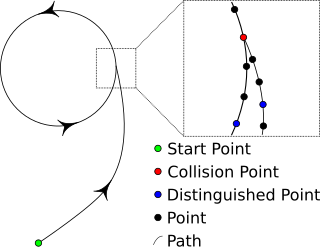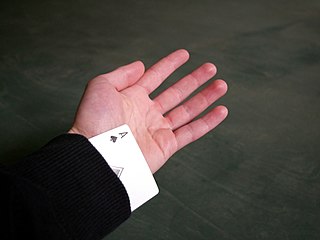
In cryptography, an HMAC is a specific type of message authentication code (MAC) involving a cryptographic hash function and a secret cryptographic key. As with any MAC, it may be used to simultaneously verify both the data integrity and authenticity of a message. An HMAC is a type of keyed hash function that can also be used in a key derivation scheme or a key stretching scheme.
The MD5 message-digest algorithm is a widely used hash function producing a 128-bit hash value. MD5 was designed by Ronald Rivest in 1991 to replace an earlier hash function MD4, and was specified in 1992 as RFC 1321.

RIPEMD is a family of cryptographic hash functions developed in 1992 and 1996. There are five functions in the family: RIPEMD, RIPEMD-128, RIPEMD-160, RIPEMD-256, and RIPEMD-320, of which RIPEMD-160 is the most common.
In cryptography, SHA-1 is a hash function which takes an input and produces a 160-bit (20-byte) hash value known as a message digest – typically rendered as 40 hexadecimal digits. It was designed by the United States National Security Agency, and is a U.S. Federal Information Processing Standard. The algorithm has been cryptographically broken but is still widely used.
Articles related to cryptography include:

A cryptographic hash function (CHF) is a hash algorithm that has special properties desirable for a cryptographic application:

In cryptography, MD5CRK was a volunteer computing effort launched by Jean-Luc Cooke and his company, CertainKey Cryptosystems, to demonstrate that the MD5 message digest algorithm is insecure by finding a collision – two messages that produce the same MD5 hash. The project went live on March 1, 2004. The project ended on August 24, 2004 after researchers independently demonstrated a technique for generating collisions in MD5 using analytical methods by Xiaoyun Wang, Feng, Xuejia Lai, and Yu. CertainKey awarded a 10,000 Canadian Dollar prize to Wang, Feng, Lai and Yu for their discovery.
In cryptography, Tiger is a cryptographic hash function designed by Ross Anderson and Eli Biham in 1995 for efficiency on 64-bit platforms. The size of a Tiger hash value is 192 bits. Truncated versions can be used for compatibility with protocols assuming a particular hash size. Unlike the SHA-2 family, no distinguishing initialization values are defined; they are simply prefixes of the full Tiger/192 hash value.
In cryptography, a collision attack on a cryptographic hash tries to find two inputs producing the same hash value, i.e. a hash collision. This is in contrast to a preimage attack where a specific target hash value is specified.
The MD2 Message-Digest Algorithm is a cryptographic hash function developed by Ronald Rivest in 1989. The algorithm is optimized for 8-bit computers. MD2 is specified in IETF RFC 1319. The "MD" in MD2 stands for "Message Digest".

In cryptography, nothing-up-my-sleeve numbers are any numbers which, by their construction, are above suspicion of hidden properties. They are used in creating cryptographic functions such as hashes and ciphers. These algorithms often need randomized constants for mixing or initialization purposes. The cryptographer may wish to pick these values in a way that demonstrates the constants were not selected for a nefarious purpose, for example, to create a backdoor to the algorithm. These fears can be allayed by using numbers created in a way that leaves little room for adjustment. An example would be the use of initial digits from the number π as the constants. Using digits of π millions of places after the decimal point would not be considered trustworthy because the algorithm designer might have selected that starting point because it created a secret weakness the designer could later exploit—though even with natural-seeming selections, enough entropy exists in the possible choices that the utility of these numbers has been questioned.
Bart Preneel is a Belgian cryptographer and cryptanalyst. He is a professor at Katholieke Universiteit Leuven, in the COSIC group.
SHA-2 is a set of cryptographic hash functions designed by the United States National Security Agency (NSA) and first published in 2001. They are built using the Merkle–Damgård construction, from a one-way compression function itself built using the Davies–Meyer structure from a specialized block cipher.
Hans Dobbertin was a German cryptographer who is best known for his work on cryptanalysis of the MD4, MD5, and original RIPEMD hash functions, and for his part in the design of the new version of the RIPEMD hash function. He was a member of the German Federal Office for Information Security and professor at the Ruhr University in Bochum.

Cryptography, or cryptology, is the practice and study of techniques for secure communication in the presence of adversarial behavior. More generally, cryptography is about constructing and analyzing protocols that prevent third parties or the public from reading private messages. Modern cryptography exists at the intersection of the disciplines of mathematics, computer science, information security, electrical engineering, digital signal processing, physics, and others. Core concepts related to information security are also central to cryptography. Practical applications of cryptography include electronic commerce, chip-based payment cards, digital currencies, computer passwords, and military communications.
SHA-3 is the latest member of the Secure Hash Algorithm family of standards, released by NIST on August 5, 2015. Although part of the same series of standards, SHA-3 is internally different from the MD5-like structure of SHA-1 and SHA-2.
The following tables compare general and technical information for a number of cryptographic hash functions. See the individual functions' articles for further information. This article is not all-inclusive or necessarily up-to-date. An overview of hash function security/cryptanalysis can be found at hash function security summary.
The following outline is provided as an overview of and topical guide to cryptography:
This article summarizes publicly known attacks against cryptographic hash functions. Note that not all entries may be up to date. For a summary of other hash function parameters, see comparison of cryptographic hash functions.
Streebog is a cryptographic hash function defined in the Russian national standard GOST R 34.11-2012 Information Technology – Cryptographic Information Security – Hash Function. It was created to replace an obsolete GOST hash function defined in the old standard GOST R 34.11-94, and as an asymmetric reply to SHA-3 competition by the US National Institute of Standards and Technology. The function is also described in RFC 6986 and one out of hash functions in ISO/IEC 10118-3:2018.






